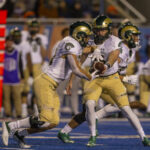The haversack was an indispensable component of the US Marines uniform, serving as a white linen or muslin bag designed for carrying sustenance, utensils, and small personal belongings. Typically, these bags measured around 12 x 12 inches and featured a flap that was securely fastened with three metal buttons.
For larger necessities, Marines relied on the knapsack. This was generally crafted from robust linen cloth folded in half to form a square, providing ample space for sleeping gear, hygiene essentials, spare clothing, and additional personal items. To organize these contents, a cloth pouch was sewn into each half of the knapsack. The pack flap often received a painted layer as a waterproofing measure. It was also a common practice to adorn the flap with the regiment’s crest, signifying unit affiliation.
Hydration was addressed with the canteen. Marines typically utilized either a wooden drum canteen, suspended from a leather strap, or a kidney-shaped tin canteen, carried by a cord. These canteens were vital for carrying water and other liquids during marches and campaigns.
Equipment belts, adjustable for a comfortable fit, were made from ‘whitened buff’ or natural leather and were essential for distributing the weight of equipment. One belt was worn diagonally from the left shoulder to the right hip, specifically designed to support the weight of the cartridge box. The cartridge box, also known as a soft pouch, was constructed from black leather and contained a wooden block with precisely drilled holes to hold 18-24 pre-rolled paper cartridges, crucial for ammunition management. A sturdy black saddle-leather flap secured the pouch, protecting the cartridges from adverse weather conditions.
An adjustable waist belt provided support for a leather frog, or slot, used to attach the bayonet. Despite the increasing popularity of a second adjustable shoulder belt (worn from the right shoulder to the left hip), Marines often preferred to maintain the use of the waist belt for bayonet carriage, reflecting a preference for familiar and reliable equipment configurations.
Finally, swords served as indicators of rank within the US Marines. Marine officers and sergeants were uniquely authorized to carry swords as personal defense weapons, distinguishing them from lower ranks and symbolizing their leadership roles.

